
|
COLOUR & PATTERN VARIATIONS IN OTHER BIG CATS |
Mutants are natural variations which occur due to spontaneous genetic changes or the expression of recessive (hidden) genes. Recessive genes show up when there is too much inbreeding. White tigers and white lions are uncommon in the wild as they lack normal camouflage. Albinism (pure white), chinchilla (white with pale markings) and melanism (black) are the commonest mutations. Erythristic (red), leucistic (partial albinism/cream) and maltesing (blue) are also been reported. Sometimes the markings are aberrant e.g. too sparse or too heavy (abundism), giving the appearance of a pale or dark individual. White, black, red, blue or cream mutations are similar to those found in domestic cats. Sometimes the pattern is different from normal e.g. the blotched King Cheetah or an normally coloured individual may have anomalous black patches (mosaicism) or white patches (partial albinism). Rufism refers to the richness of the red colour in tawny-coated cats.
As well as anomalous colours, there are abnormally large or small individuals, longhaired individuals, short-tailed or even tail-less individuals. All of these occur in domestic cats so why are they less common in big cats? Wild cats displaying these traits may be less likely to survive to pass on the traits. In captivity, humans control which traits are bred, hence the multitude of domestic cat colours and types. In the wild, nature selects against any trait which does not enhance the animal's survival chances.
In the past, the obvious reaction to any unusual big cat was to shoot it for the trophy room. As a result, many interesting mutations may have been wiped out before the genes were passed on. Some colour mutations which would disadvantage a wild big cat are bred in captivity and are not viable in the wild. It is questionable whether these mutants should be perpetuated for the sake of curiosity or aesthetics alone.
CARACAL MUTATIONS
Melanistic individuals are relatively common. The normal colour is tawny or golden with black-tufted ears. It is sometimes known as the Desert Lynx or Caracal Lynx. Black Caracals have been reported from Nigeria, Uganda and from Kaffraria, South Africa. A case of dwarfism has been reported in a captive bred Caracal.

Above: Two different colours of caracal. Photo by Mindy Stinner, Conservators Center, Inc.
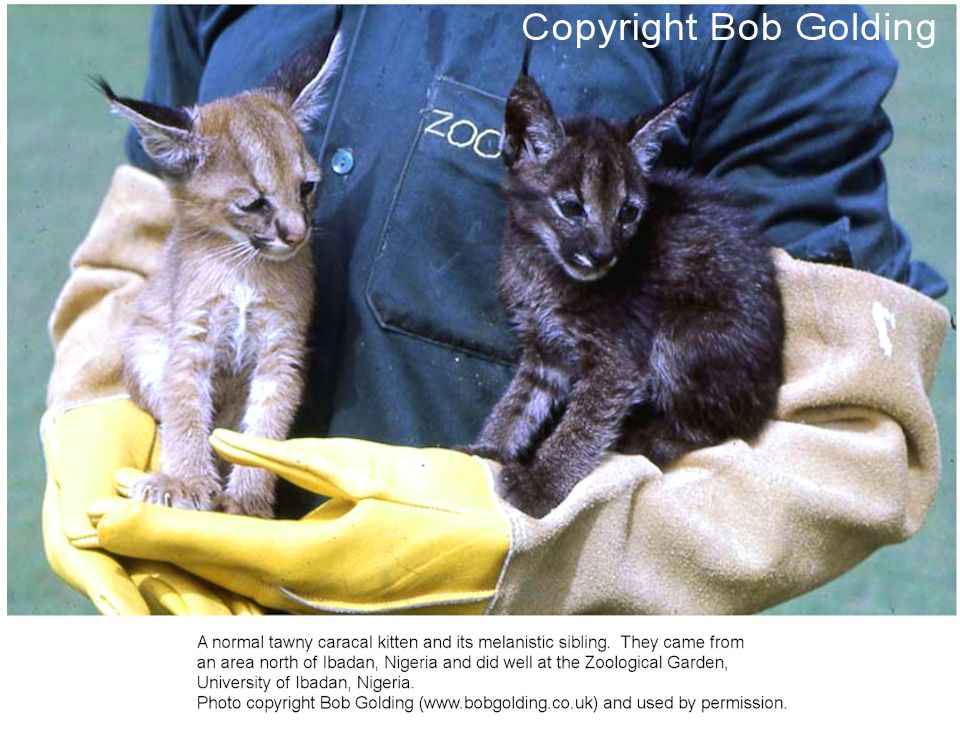
OCELOT MUTATIONS
Red (erythristic) ocelots have been recorded. These represent non-extension of the black gene, changing the normal black markings to red.
JUNGLE CAT MUTATIONS
Black (melanistic) jungle cats are known and their melanism appears to be due to a dominant gene. A pair of black Jungle cats in Cincinnati zoo had both black and normal coloured offspring. Black jungle cats have silver-tipped fur and this colour has been introduced into the Chausie (jungle cat x domestic hybrid breed) using melanistic jungle cat sires.
ASIAN LEOPARD CAT MUTATIONS|
|
|
In 2002, Mr Musa Kiana of Chelmsford, England photographed an albino "Jungle Cat" in a marshy region near a remote Bengali village on the border between India and Bangladesh. He took 11 pictures of the albino cat which has no pigmentation except for white and pink. Its eyes are a deep red. Photos of the cat were sent to Colchester Zoo experts and also to London Zoo and University of Cambridge for comments. At first it was thought to be a juvenile white tiger. Musa wrote to me on 11th August 2002 to say that the cat had been confirmed by Colchester Zoo as a true albino cat, but the species had not been identified (hence it has been named after his Norwegian female friend 'Gunvor'). His main concern is the wellbeing of the albino cat which is currently in a small cage in a back garden, somewhere in the Indian sub-continent. Its location is secret because of the risk of bounty hunters and thieves.
Musa tried to get support for a rescue bid so that the cat can be kept in more suitable conditions and no longer at risk. He has been unable to get any support or interest from UK based charities and may have to sell the photos (something he had hoped not to do) in order to fund a rescue effort himself. There has been little interest from experts in the UK and really needs the attentions of cryptozoologists to identify the cat's species. He writes, "I do still believe it's the only known pure albino in the world and the most beautiful creature I have had the pleasure of seeing, but it does need proper care and attention, which few out in that region have the know how or the ability." In August 2002 I was privileged to meet Musa and view the Gunvor photographs in the hope of working out what the albino cat is not as much as what it might be.
The albino is approximately 46 inches long and stands 24 inches tall. It is male and approximately 3 years of age (judging by dentition) and had been in captivity for several months. It was able to survive despite its striking colouration - either by nocturnal hunting or by scavenging from the local village(s). The most striking feature - and the greatest problem in identification - is the colour. It is a true albino with pink eyes which reflected the camera flash very well (not the usual green-eye associated with cats). The nose and mouth are pink and the skin of the ears is pink. It is possible to distinguish its pale pink skin in many areas through the white fur. Although wild, it is said to tolerate the approach of its keeper.
The absence of any pattern (not even ghost markings) made it hard to identify a species (Jungle Cat [F chaus] or Leopard Cat [F bengalensis]). On August 19th, 2002, Musa met with a senior member of staff at the University of Cambridge, Dr Adrian Friday, University Lecturer and Curator of Vertebrates (University Museum of Zoology) who confirmed it to be a true albino Leopard Cat, rather than a Jungle cat. Because the gene for albino is carried as a recessive there is a chance it is still in the population of whichever species Gunvor represents and may occur again. Since Gunvor is a mature male, there is an excellent chance that he has bred and passed on the albino gene.
The Asian Leopard Cat is the wild parent of the Bengal breed; albino Bengal cats have occurred. An erythristic (red/golden) leopard cat has also occurred.
|
|
In March 2012, The Times Of India Kolkata described a "mystery cat" in the Sunderbans tiger reserve. Forest officers came across a small, black cat with a long tail spotted in the camera traps in Raidighi. There were no records of such a cat and although it resembled a small version of the black leopard, leopards have not been recorded in the region since 1931. Initially, experts believed it might be a new species of the wild cat with similarities to the fishing cat, leopard cat or marbled cat. After discussions with other carnivore experts, it was identified as a melanistic Leopard Cat on the basis of its tail length: a fishing cat's tail is about a third the length of its body, whereas a leopard cat's tail is about half the length of its body.
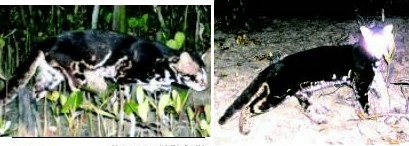
GEOFFROY'S CAT MUTATIONS
Geoffroy's Cat is a little larger than a domestic cat and is usually spotted. Melanistic Geoffroy's cats have occurred.
|
|
|
KODKOD MUTATIONS
The Kodkod (Guina) is a small cat from Chile. Melanistic Geoffroy's cats have occurred.

INDIAN (TEMMINCK'S) GOLDEN CAT MUTATIONS
Temminck's Golden Cat (F temmincki), or Asiatic/Indian Golden Cat, also has variable markings. One of its subspecies, Fontainier's Cat, a large form found in Burma and Tibet, has markings similar enough to the Asian leopard Cat that it was once considered a subspecies of Asian Leopard Cat instead. Basel Zoo had a melanistic Temminck's Cat (Asiatic Golden Cat).
|
Melanistic individuals have been reported.
Photo: http://www.bigcats.org |
|
There is another species of Golden Cat called the African Golden Cat (F aurata). In 1827, Dutch zoologist Professor CJ Temminck described a grey (silver) cat he called F celidogaster and considered a different species to the familiar tawny-coloured African Golden Cat. The Golden and Grey (Silver) versions were classed as separate species until June 1906 when London Zoo's newly arrive Golden Cat moulted its tawny coat and grew a grey coat in its place. It turned out that the African Golden Cat had two colour phases. In addition, African Golden Cats have variable markings and western versions are heavily spotted while eastern specimens are generally plain.
BOBCAT MUTATIONS
|
|
Photo: http://www.bigcats.org |
Melanistic (black) bobcats have been reported. A stuffed melanistic bobcat is on display at Totemin Zoo in Wilmington North Carolina, albeit in bad repair. It apparently dates from the 1970s and was collected in Florida. Melanistic bobcats have not been reported outside of Florida. Some details was lost during taxidermy and http://www.bigcats.org report that the faint markings do not follow the common bobcat pattern, the ear furnishings are different and there is no "beard" or ruff. This does not rule out melanism, nor does it rule out hybridisation with domestic cats.
According to Fred A Ulmer Jr in "Melanism in the Felidae, with Special Reference to the Genus Lynx" (Journal of Mammalogy, Vol. 22, No. 3 (Aug., 1941), pp. 285-288), on April 18, 1939, Vincent Nelson and J Townsend Sackett live-trapped a melanistic male Florida bobcat (Lynx rufus floridianus) in Martin County, Florida, 14 miles above the mouth of the Loxahatchee River. An experienced trapper, Martin had caught many bobcats, but had not previously seen a black one. The black bobcat was secured by Sackett for the Zoological Society of Philadelphia and exhibited at their Zoological Gardens from late April through to August 3, apparently dying of feline infectious enteritis (described as distemper by Ulmer). Its skin and skull went to the collection of the Acadamy of Natural Sciences of Philadelphia (specimen no 19842) where Ulmer later examined the skin. In January 1940, Nelson live-trapped a melanistic female bobcat in the same region. This was caught about 2 miles from the first specimen, in swampy jungle lose to the confluence of Kitachen Creek and Loxahatchee (or Jupiter) River. Dr Raymond L Ditmars obtained the melanistic female for the Bronx Park Zoo.
Ulmer examined the skin of the Philadelphia specimen and described it as follows (it should be noted that melanistic fur frequently pales to dark brown during the preservation process): "The Academy specimen, upon close examination, is far from black. The most heavily pigmented portions are the crown and dorsal area. In most lights these appear black, but at certain angles the dorsal strip has a decidedly mahogany tint. The mahogany coloring becomes lighter and richer on the sides. The underparts are lightest, being almost ferruginous in color. The chin, throat and cheeks are dark chocolate-brown, but the facial stripes can be clearly seen. The limbs are dark mahogany. In certain lights the typical spot pattern of the Florida bobcat can be distinctly seen on the sides, underparts and limbs. The Bronx Park animal appears darker and the spots are not visible, although the poor light in the quarantine cage may have been the reason. Numerous white hairs are scattered through the dark dorsal strip in both animals. The normal bobcat's dorsal area is similarly sprinkled with white hairs, but in the light, grizzled pelage they are scarcely noticeable. A small patch of white hair occurs in the inguinal region of the Academy's specimen. The Bronx individual has a larger white inguinal patch."
Their whiskers were slightly darker than those of normally pigmented bobcats, but their facial ruffs were short and inconspicuous which, along with their sleek black fur, made them resemble large domestic cats (this absence of ruffs, along with the colouration and white patches is also suggestive of introgressive hybridisation with domestic cats in the same way that black Kellas cats have arisen from hybridisation between Scottish wildcats and domestic cats carrying the non-agouti gene)
There have long been accounts of Black Florida Panthers the size of a Labrador dog. One such cat was captured in 2007 in Martin County, Florida and researchers at the Busch Wildlife Sanctuary were able to identify it. The "Black Panther" trapped in a back garden where it had killed domestic poultry turned out to be a 16 lb melanistic bobcat (black all over apart from a white spot on the belly). There have 13 previous confirmed (killed, captured or photographed) melanistic bobcats in south and south central Florida since 1939; most having been in the region of the Loxahatchee River and St Lucie Canal. The 2007 case was in the environs of the St Lucie Canal. After running DNA tests to ensure the animal is fully and officially documented, the black bobcat will be released back into the wild. It was about 2 years old and male, making it likely the recessive melanism gene will be perpetuated the local bobcat population.
Bobcats are normally tawny/rufous with black markings though blue-grey bobcats and red bobcats have also have been reported. There have been increasing numbers of reports of albino bobcats.
ALBINO BOBCAT SIGHTED SOUTH OF MARQUETTE The Escanaba Daily Press, 22nd October 1954
Gwinn - Dr. Edward F. Kronschnabel, Gwinn physician and an active member of the Forsyth Township Sportsmen's Club, reports what must have been an eerie sight. On two occasions while driving at night on County Road 553 between County Road 480 and the Marquette city limits, he has seen an albino bobcat. The area is a lonely, rugged stretch of country - suitable habitat for wildcats, even albino wildcats.
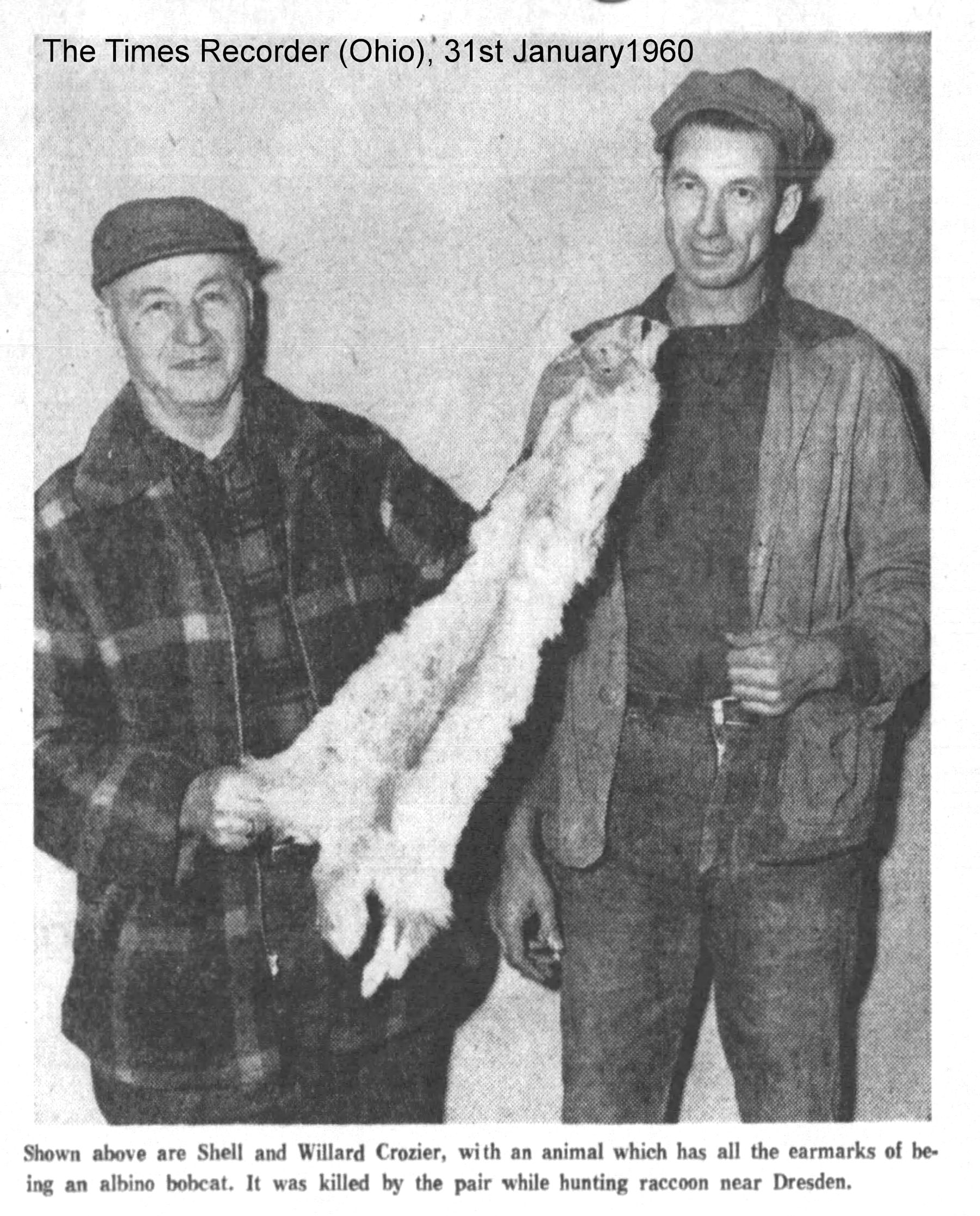
Although this report referred to an albino bobcat, it appears to have been an unusually pale bobcat (cream/isabelline) rather than pure white.
AREA HUNTERS BAG ALBINO BOBCAT (The Times Recorder, 31st January, 1960). If the fortunes of some of Muskingum County's racoon hunters so far this year are any indication of what's in store for us the balance of 1960, then we can look forward to one cock-eyed year. Recently we had a story about two coon hunters killing an albino racoon. This past week we picked up a story of how Shell and Willard Crozier, while coon hunting, killed an albino bob-tail cat. (At least I'll say it was a bob-tail until proven wrong.) It's often that racoon hunters tangle with "wild cats." From the size and ferocity of these animals, they are often thought to be the real McCoy, wildcats. Until the Croziers brought in the cat they killed, all that I have seen have been domestic cats gone wild. But the beast Shell and Willard brought in was like no domestic cat I've ever seen. They had skinned the animal, expecting to have the hide tanned, when I saw it. I never have, and I hope I never do bump into a bob-tail cat at night in the woods. In fact the only ones I ve seen alive have been in zoos. Except for the color, this cat I saw had all the ear marks of a bob-tail.
The pair were coon hunting one night early last week when their hounds, after a rather short chase, let it be known that they had an animal treed. Willard brought it down with a single shot from his 22 rifle. They, in all their years of hunting, had never seen anything like what fell out of that tree. The animal shaded from a light buff color down the middle of its back to a cream-white on its belly. It had exceptionally long legs, standing 15 inches high. Its ears were long and pointed, and it had long, mighty mean looking fangs. Instead of a tail like a tabby cat, this beast had a tail only three or four inches long, a couple inches wide, and fiat rather than round. Its whiskers were white and as stiff as wire. The animal weighed 16 pounds. Even after being skinned, that animal's mug had a mighty mean look. You might ask why a bob cat would run from a pair of hounds. I think the answer to that would be that the "cat" was so full of rabbit that it just wasn't in fighting condition. When it was skinned it was found to have a tummy full of rabbit fur as well as other indications of a recent bunny kill.
The animal was killed in the Dresden vicinity. There may be more of the same breed roaming about those wooded hills, for Willard said he had seen tracks that looked like they had been made by cats, cats about like the one he and his dad killed. Over the years we've heard rumors of wildcats having been seen in this area. We've investigated most of these and, up until this time they've turned out to be domestic cats gone wild. As often happens, I may be mistaken in claiming this to be a bob cat. But until someone who really knows his wild animals tells me differently, I'll still say it was a bob cat.
ALBINO BOBCAT. The Anniston Star, 19th November 1964
Bobcats are still in the news, too. Last Sunday's "bag" noted a white one killed near White Plains. Well, now there is an albino bobcat who won't be seen any more in the woods. I'm told H. J. Smith of Anniston shot the white bobcat last week while he was hunting near Wedowee in Randolph County. The only non-white spot was reportedly a black ring near the tip of its tail.
IT WALKS ON 4 LEGS AND ISN'T HUMAN Daily Press, Newport Virginia, 13th July 1984

Gloucester - Residents of Woods Cross Roads do not really believe a 60-pound albino bobcat is prowling their neighborhood. But they have a trap set, just in case. For several weeks, reports of a large, marauding feline have circulated among neighbors in the lightly populated wooded area near the end of Route 612, close to Route 17.
"There’s something out there, but I don’t know what it is," said Margaret Coin, who considers it her duty as co-captain of the local Neighborhood Watch program to investigate. Descriptions vary. Ms. Coin said that a construction worker described it as weighing in at 60 to 80 pounds, "snow-white, with big pointy ears and a large head," while others described it simply as an unusually large, white cat. Small housecats have been reported missing in recent weeks, said neighbor Nancy Milby.
David J. Gordinier of Woods Cross Roads reported something attacked his Weimaraner dog, leaving a deep gash. Veterinarian Gilbert Birdsall of the Gloucester Veterinary Hospital Ltd., where Gordinier's dog was treated, said the wound could have occurred in a fight with any normal-size cat or dog. A likely suspect in the attack, Birdsall said, is a large Persian cat that is known to live wild in Woods Cross Roads, eating out of garbage cans. Bobcats occasionally are spotted in sparsely populated, wooded areas on the Middle Peninsula, Birdsall said. The average bobcat weighs 25 to 30 pounds, he said.
But Dudley Saunders, who lives in the area, said a dog treed a large animal near his yard one night three weeks ago. He shined a flashlight 30 feet up the tree, he said, and saw "a bobcat, a pretty good-size one, with white markings all over it. It's funny how stories will travel," Saunders said. "By now it must have gotten bigger. A hundred pounds or so?"
On Thursday, several residents contacted Bonnie Jones, director of the Gloucester-Mathews Humane Society, who persuaded Mathews County animal warden Al Mellen to lend them a box trap used for capturing large dogs. When the animal lifts the food bait off a plate, the box falls and imprisons him. Neighbors have agreed to check the trap several times a day. Mellen is skeptical. "I loaned a lady a trap to catch something. I don’t know what it was all about. That’s all I want to say," he said.
"We're all kind of dubious, I suppose," Ms. Coin said. "I hope the whole thing gets resolved and we catch something – if there's anything there."
LYNX MUTATIONS
(ALBINO LYNX) Rutland News (Vermont, USA), 30th August 1919
Rutland sportsmen are interested in an albino lynx which was captured by Charles Day of Hydeville and is on exhibition at his home.
Melanistic (black) lynxes have been reported, but until 2020 there were no documented/photographed sightings. A melanistic Canada Lynx was filmed about eight kilometres southeast of Whitehorse, Yukon, Canada in 2020, and is believed to be the first fully documented record of melanism for that species. There were whitish, grey hairs across the cat's body that were more pronounced on its face and back. Melanism is not an advantage for Canada lynx as they hunt hares in snowy terrain where the normal silvery-grey coat gives better camouflage. A warming climate and reduced snow cover may make melanism less of a disadvantage.
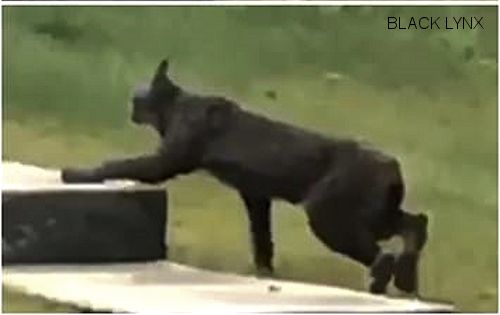
In 1938, a blue lynx pelt was donated to the US National Museum by Mrs Charles D. Walcott. The pelt came from an animal trapped somewhere in Alaska). In place of the normal fawn colour, this pelt was bluish-grey all over. It exhibited the pale inner limbs and belly found in normal lynxes, but instead of the normal black tail-tip and ear-tufts, the specimen had a darker blue-grey tail-tip and ear-tufts. On investigation, it turned out that the animal had no black colouration at all. This is the same as the dilute mutation in domestic cats - normally black areas are instead expressed as bluish-grey (the chinchilla mutation would have resulted in black markings on a silvery background). Enquiries were made to the fur trade; furriers stated that the mutant grey form was observed once or twice in every thousand lynx skins.
In 2005 I was informed of a piebald (grey and white) lynx that was released in Colorado as part of a reintroduction scheme (possibly in the region of the San Juan Mountains). No mention was made of its unusual pattern when it was released, but photos show its white markings. The pattern corresponds closely to the bicolour pattern seen in domestic cats - white blaze on the face, white legs, white chest and belly - and might be due to a similar gene mutation in the lynx rather than partial albinism. If so, the white spotting gene can be expected to turn up in the lynx's descendants.
|
|
|
|
A drab blue lynx was noted in 1892, together with a yellow lynx. The yellow lynx indicates a mutation where black pigment is replaced with yellow or red (non-extension of the black gene). The lynx below is almost white with a black tail-tip and was caught in Tibet; its body is displayed at the Rothchild Zoological Museum in Tring, England. The yellowish cast is due to the lighting used (to prevent specimens from discolouring).
|
|
|
The construction of the Alqueva dam in Eastern Portugal creates Europe's biggest reservoir in a known Iberian Lynx Territory. As the lynx population becomes more fragmented by human-made obstacles, the lynx groups become inbred and inbreeding depression occurs. The loss of genetic diversity means some fur patterns have been disappearing while melanistic lynx have emerged due to recessive genes doubling up.
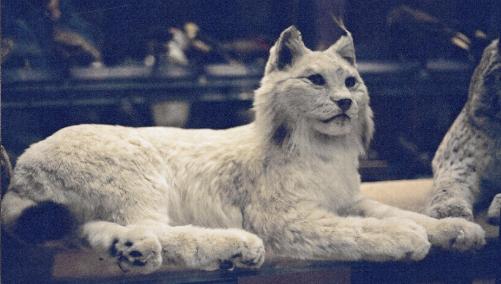
CLOUDED LEOPARD MUTATIONS
There have been pure black specimens reported of the Clouded Leopard. In spring 1946, the skin and lower jaw of a black Clouded Leopard were obtained in Borneo. Another black Clouded Leopard was reported on Mount Matang (undated, but possibly around the same time). Six reports of melanistic Clouded Leopards were made in 1982 in Sabah. In 1986, there were three sightings of black Clouded Leopards in Sarawak, plus one sighting from Sabah. There have been no live captures of melanistic Clouded Leopards or recent skins (for DNA testing) to prove this issue beyond doubt.
FISHING CAT MUTATIONS
An albino Fishing Cat has been reported.
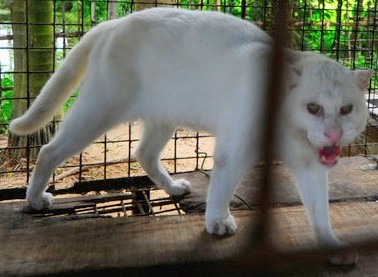
JAGUARUNDI MUTATIONS
In South America, there are two colour morphs of Jaguarundi. The red form was known as the Jaguarundi and the grey form was considered a separate species and called the Eyra.
EUROPEAN WILDCAT MUTATIONS
THE BLACK WILD CAT OF TRANSCAUCASIA. By C. Satunin, of Tiflis, C.M.Z.S. (Proc. Zool. Soc June 7, 1904.)
Although the existence in Transcaucasia of a Black Wild Cat was known long ago, the animal has never been described nor scientifically named. Hochenacker speaks of this cat, so far back as 1837 [Bull. Soc. Nat. Moscou, 1837, p. 136], as a Fells catus affinis; but as all his text is in Latin, this cannot be regarded as a scientific name for the animal. I myself have mentioned this cat as Felis sp. in my paper on the Fauna of the Caucasus [Zool. Jahrb., Syst. ix. p. 289 (1897)], as well as in the Catalogue of the Caucasian Museum ['Museum Caucasieum,' i. p. 21-( 1899)]; but I have not had the opportunity of giving a description of it until now. That it really is a Wild Black Cat I knew well, as all the specimens I have had the opportunity of examining were alike, and as it is by no means rare in its native haunts.
There remained one important point to decide about this animal, namely, was it not a melanic form of the common Wild Cat, Felis catus L.? Thanks to the material in the Zoological Museum of the St. Petersburg Academy of Sciences, where I have found two mounted specimens, three skins, and three skulls of this cat, I am now certain of its specific validity, and I name it Fells daemon [ Daemon" being the hero of several Caucasian legends, and also of the poem by Lermontoff with the same title], of which the following is the description:
Size of a big male domestic cat. Colour ranging from black with a slight reddish tinge to reddish dark brown. This colouring is somewhat lighter on the underside of the body, on the inner surface of the extremities, and on the distal under surface of tail. Very long white hairs are scantily dispersed all over the body. In a certain light, dark-black transversal stripes are visible on the sides of the fore part of the body, these stripes being more conspicuous on somewhat faded skins. The whiskers, as well as the eyebrow-bristles, are brown. The tail is considerably longer than in Felis catus. Claws white, transparent, and with a mother-of-pearl lustre.
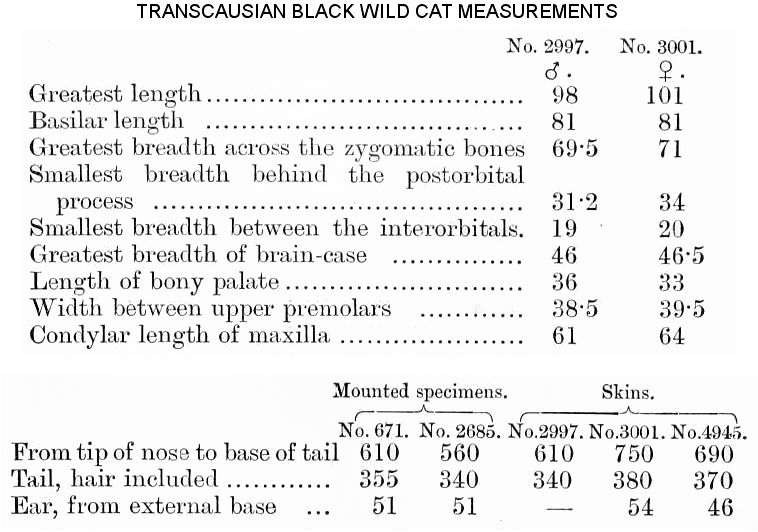
The measurements, in millims., of the two mounted specimens and of the three skins are:
Mounted specimens: No. 671. No. 2685.
Skins: No.2907. No.3001. No.4945.
From tip of nose to base of tail No. 671: 610; No. 2685: 560; No.2907: 610; No.3001: 750; No.4945: 690
Tail, hair included No. 671: 355; No. 2685: 340; No.2907: 340; No.3001: 380; No.4945: 370
Ear, from external base No. 671: 51; No. 2685: 51; No.2907: -; No.3001: 54; No.4945:46
Skull : as compared with the skull of Felis catus that I have had for comparison, the three skulls of this new cat differ only in that the frontal part is somewhat narrower. Moreover, in Felis catus the nasals reach further back than the ascending brunches of the upper mandible, whereas in Felis daemon the upper mandibular bones go further back than the nasals.
The measurements of two complete skulls, No. 2997 (m), No. 3001 (f), in millims., are :
Greatest length- No. 2997 (m): 98; No. 3001 (f):101
Basilar length - No. 2997 (m): 81; No. 3001 (f): 81
Greatest breadth across the zygomatic bones - No. 2997 (m): 69.5; No. 3001 (f): 71
Smallest breadth behind the postorbital process - No. 2997 (m): 31.2; No. 3001 (f): 34
Smallest breadth between the interorbitals. - No. 2997 (m): 19; No. 3001 (f): 20
Greatest breadth of brain-case - No. 2997 (m): 46; No. 3001 (f): 46.5
Length of bony palate - No. 2997 (m): 36; No. 3001 (f): 33
Width between upper premolars - No. 2997 (m): 38.5 ; No. 3001 (f):39.5
Condylar length of maxilla - No. 2997 (m): 61; No. 3001 (f): 64
Felis daemon is not scarce in the woods of the southern slopes of the chief range of the Caucasus (Nookhinsky district of Gouv. Elizabethpol) and the Zakatalsky Province, It used to be found, according to Hochenacker, also in the mountains of the Small Caucasus ; but nothing is heard of it there at the present time. According to Radde, this cat inhabits the Kopet-Dagh Range in Transcaspia; and M. S. Alpheraky tells me that it is by no means rare in the woods of Borshom, where it is often trapped, together with Felis catus and other vermin. Habits unknown.
MELANISTIC CATS MAY BE MORE HEALTHY?
"The Smithsonian Answer Book: Cats" has an illustration of a black Geoffroy's cat and stated that genes for blackness in cats may provide resistance from viral infections. The black gene in domestic cats is different from the black gene in jaguars and jaguarundis (black jaguarundis may be supplanting the red form). Both genes are different from black genes in 5 other species. The same gene is involved in jaguars and jaguarundis, but the mutation is different in each. The melanism mutation appears to have evolved at least 4 times and possibly 9 times. A viral epidemic may explain the prevalence of black leopards in Java and Malaysia, and may also explain why the Aberdares, Africa, has so many black leopards and black servals. Studies in 2003 suggested that black fur is linked to disease resistance and not merely to altitude (black absorbs more heat and has been considered a high altitude adaptation). The disease resistance theory may explain why the gene persists even though pure black individuals may be disadvantaged by it. It may confer immune advantage to the normally patterned carriers (in recessive gene forms of melanism). Melanism has evolved separately many times in different species of cat. One study suggested it was found in only 11 out of 37 species, others list additional species exhibiting the trait (18 species). There are no confirmed melanistic pumas. All "black tigers" to date have been due to a condition called abundism.
|
Scottish Wild cat |
Cheetah |
Geoffroy's cat |
Dark fur may have a survival benefit beyond camouflage since the mutations which lead to a black coat are in the same gene family as those involved in human diseases like AIDS. Melanistic cats may therefore have better resistance to disease than cats with "normal" colour coats (Eduardo Eizirik & Stephen O'Brien, US National Cancer Institute, Maryland).
Melanism is due to changes in the "agouti" gene which controls blackness (due to bands of colour along the hair shaft).Cats with normal agouti genes have ticked or banded hairs. Cats with 2 copies of the mutated agouti gene have solid colour hairs. In wild species this causes melanism (in domestic cats other genes affect the colour e.g. black, grey, brown). In most cat species, the gene for melanism is recessive to that for normal colour. In jaguars, melanism is a dominant gene. The gene is actually incompletely dominant and cats with 2 copies of the gene (homozygotes) are darker than those with only one copy (heterozygotes). Studies showed that black cats also had changes to a connected gene known as MC1R. MC1R is a member of a family of genes which includes the human gene CCR5. CCR5 codes for a protein on the cell membrane and this protein is a key allowing in various viruses, including HIV. Possibly black cats are less susceptible to viral infection and this, rather than better camouflage, is the evolutionary advantage.
ALBINISM AND HEALTH
Albinism is linked to poor health for a variety of reasons. Many albino animals appear to have poor immune systems compared to normally patterned individuals. This may simply be the converse of the finding that melanism is linked to greater disease resistance i.e. lack of melanism is linked to poor disease resistance. The lack of pigment makes them prone to skin cancer as they have no pigment to protect them from the sun's UV rays. The lack of pigment in the eyes makes them photo-sensitive - not a problem in a night-time hunter, but it is a handicap for a day-time hunter.
GREEN CATS?
There have, from time to time, been reports of green big cats. A green lion was reported by a prospector in the forests of western Uganda (reported 1962, but actual sighting is undated). Green fur colour in mammals is most often due to contaminants on the fur e.g. algae (where the cat has swum in algae rich water) or copper patina; or even a trick of the light - sunlight filtering through green leaves can give pale animals a green cast.
Textual content is licensed under the GFDL.
For more information on the genetics of colour and pattern:
Robinson's Genetics for Cat Breeders & Veterinarians 4th Ed (the current version)
Genetics for Cat Breeders, 3rd Ed by Roy Robinson (earlier version showing some of the historical misunderstandings)
Cat Genetics by A C Jude (1950s cat genetics text; demonstrates the early confusion that chinchilla was a form of albinism)
For more information on genetics, inheritance and gene pools see:
The Pros and Cons of Inbreeding
The Pros and Cons of Cloning
For more information on anomalous colour and pattern forms in big cats see also Karl Shuker's "Mystery Cats of the World" (Robert Hale: London, 1989; the genetics content is outdated)
|
BACK TO HYBRID & MUTANT BIG CATS INDEX |